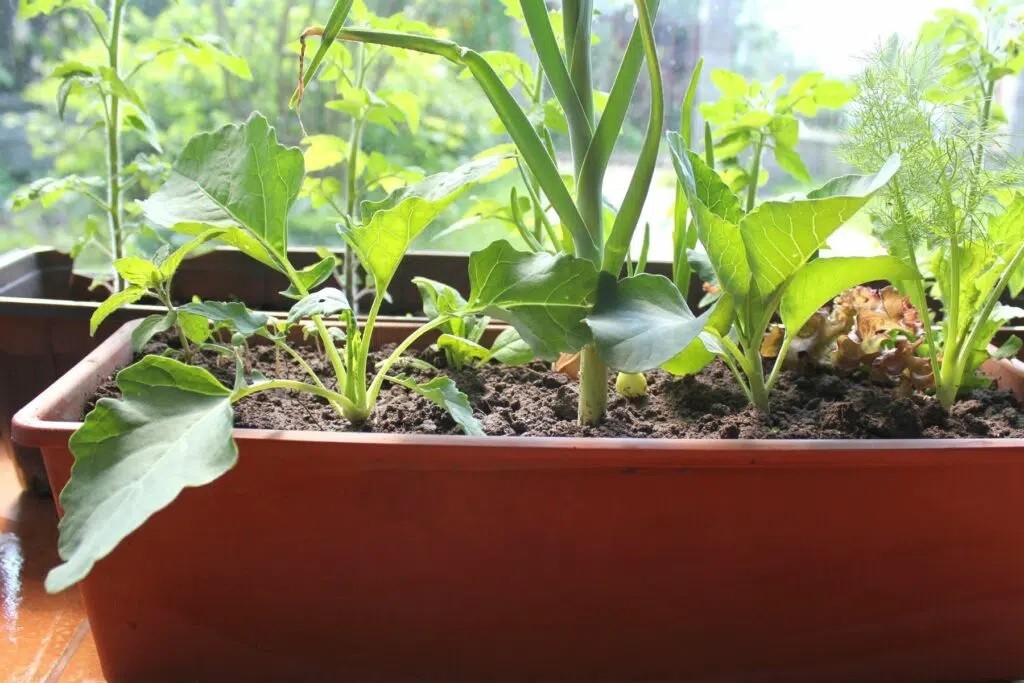Kohlrabi contains many valuable ingredients, tastes delicious and grows faster than many other cabbage vegetables. But you can enjoy these benefits only if the planting distance is correct. This distance is needed kohlrabi when planting
For the optimal development of kohlrabi (Brassica oleracea var. gongylodes), please keep your distance when planting. If the kohlrabi plants are too close, you can expect the following:
- deformed tubers due to lack of light,
- woody fruits or
- a total failure due to diseases or pests.
Contents
Varieties
The tasty vegetable comes in different varieties. In this country, you can choose from about 30 white and about 14 blue varieties of kohlrabi. The planting distance depends on the typical size of the tubers at the time of harvest.
Small tuber varieties
Small-tubed kohlrabi should be harvested at the latest when they have reached the size of a tennis ball. Popular varieties include:
- Azur Star (deep blue)
- Lanro (white-greenish)
- Noriko (white)
- Rasko (creamy white)
Tip: In order to walk comfortably between the rows of beds, you should also allow about 50 centimeters of path width. Therefore, the distance between the rows should be about 80 centimeters for small-bulb varieties.
Planting distance
- in the row: 25 to 30 centimeters
- between the rows: 30 centimeters
Large tuberous varieties
The harvest time of large-knobbed kohlrabi is usually in the fall, as they grow more slowly. In return, the tubers almost reach the size of cabbages without becoming woody. Common varieties are:
- Blari (blue, tuber weight: up to one kilogram).
- Gigant (white, tuber weight: two to three kilograms)
- Kossak (white, tuber weight: up to three kilograms)
- Superschmelz (blue, tuber weight: up to eight kilograms)
Planting distance
- in the row: 40 to 50 centimeters
- Row spacing: 110 centimeters (= 60 centimeters from plant to plant + 50 centimeters walkway)
If you want to harvest real giants from large-tubed varieties, you should allow 60 x 60 centimeters per plant, calculated without the path between the rows
Kohlrabi in the raised bed

Grow the tuber in a raised bed is a fine thing, but quickly leads to space problems. Therefore, you should give preference to small-tuber varieties. You can also save space by planting kohlrabi plants in staggered rows. For this “checkerboard” pattern, proceed as follows:
1st row:
- first plant: set with about seven centimeters of space between them and the edge
- After that: leave 15 centimeters of space between the kohlrabi plants.
2nd row:
- Distance from the 1st row: 15 centimeters
- first plant: 15 centimeters from the edge
- put other kohlrabi plants at a distance of 15 centimeters.
The third row corresponds to the first, the fourth to the second, and so on. The planting distance between the rows of kohlrabi is always 15 centimeters.
Tip: Planting kohlrabi plants in a checkerboard pattern is also suitable for a deep bed.
Balcony kohlrabi
For the cultivation of the tuber on the balcony, you should also take into account the space requirements of the plants. Since space is usually limited, it is recommended to use small-tuber varieties here as well. The distance between plants depends on the type of planter:
- round container: 25 to 30 centimeters in diameter (space for one plant).
- oblong container: 25 centimeters between the kohlrabi, width 30 centimeters.



